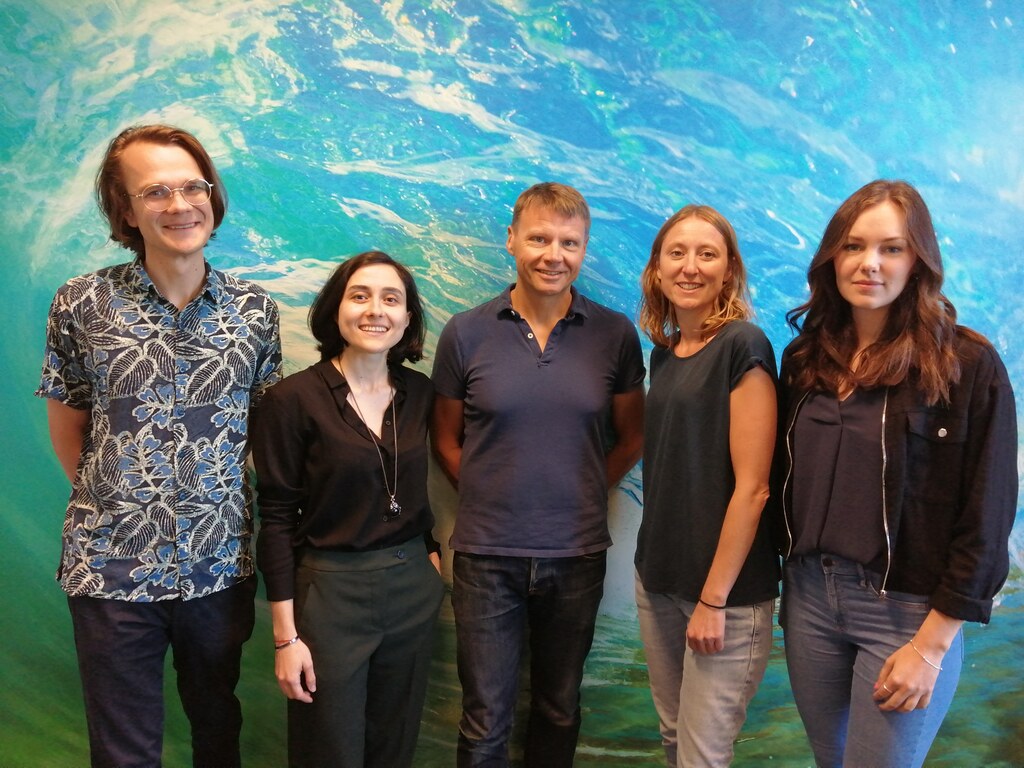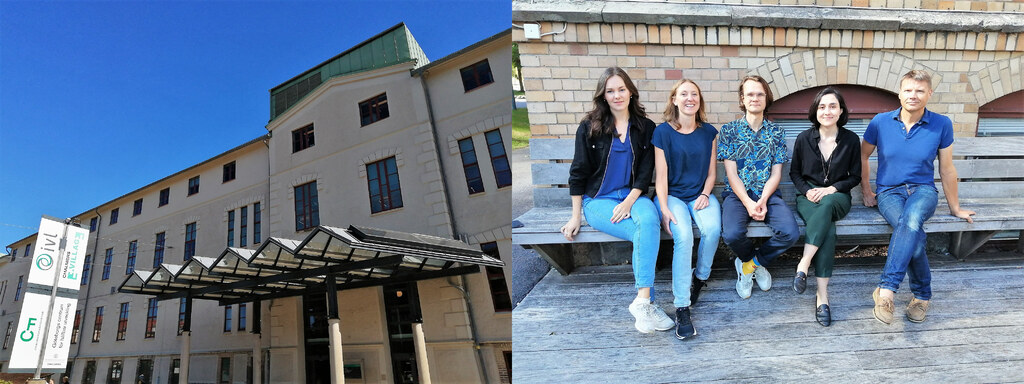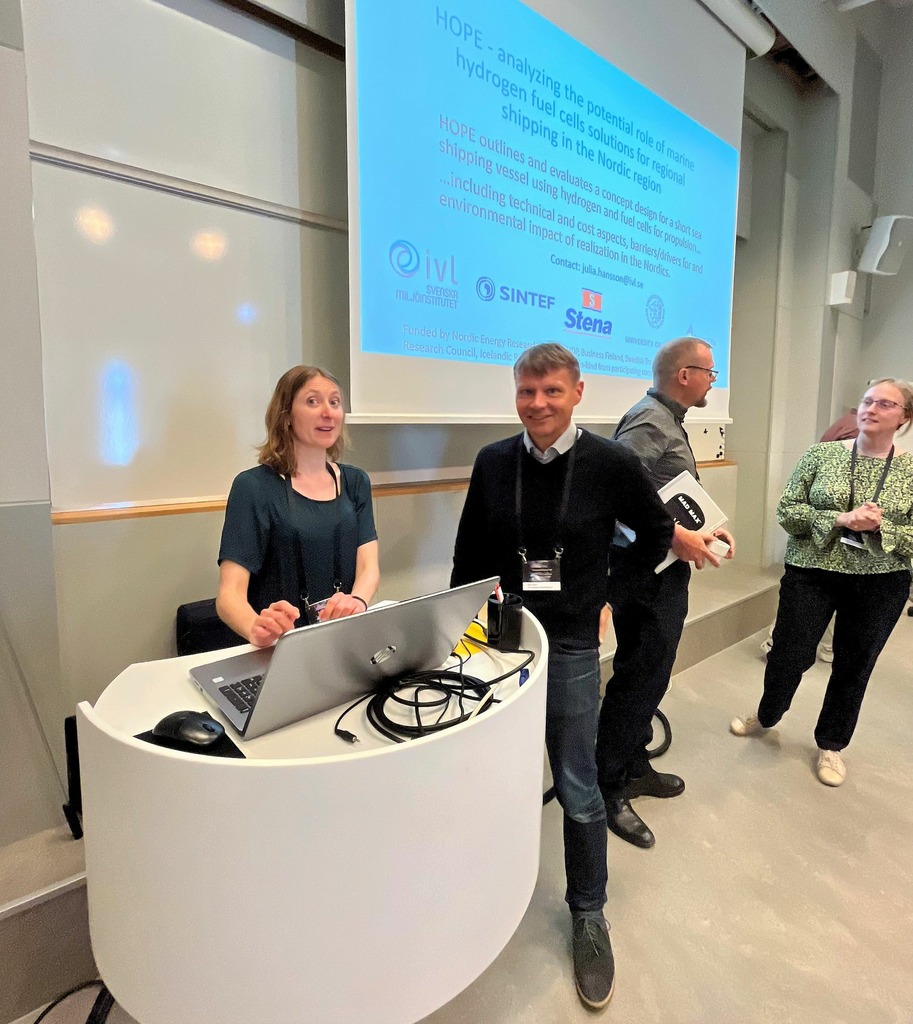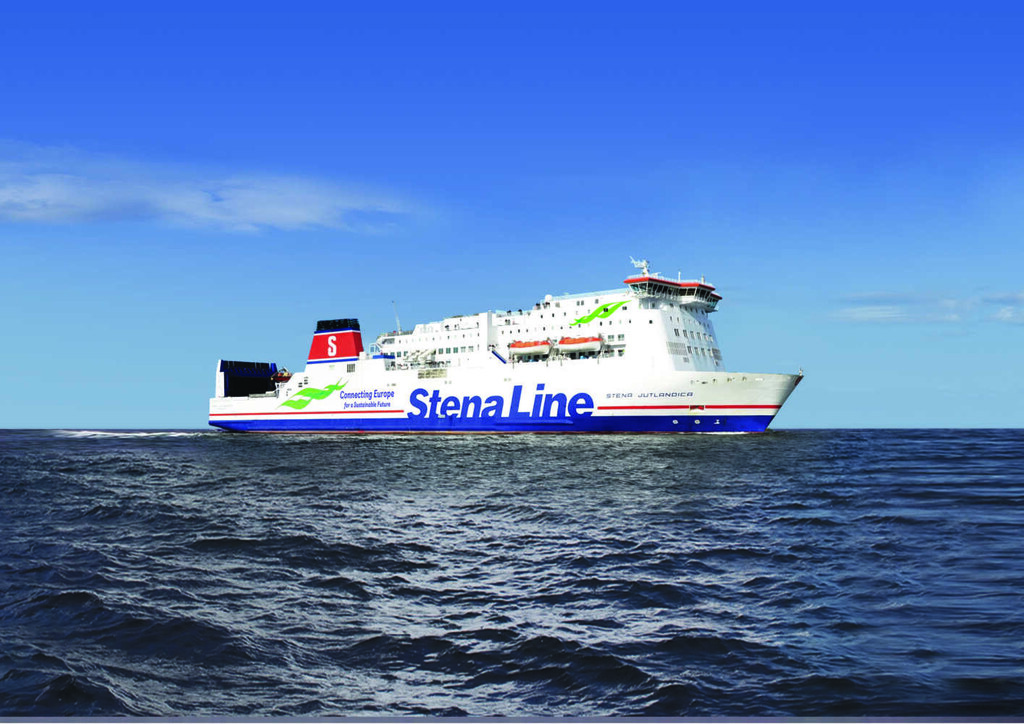
HOPE project ripples the water in maritime industry
On Monday, August 29, Nordic Energy Research paid a visit to our project partner IVL Swedish Environmental Research Institute in Gothenburg. During the visit, we were guided through the IVL…
On Monday, August 29, Nordic Energy Research paid a visit to our project partner IVL Swedish Environmental Research Institute in Gothenburg. During the visit, we were guided through the IVL facilities as well as the research project HOPE – Hydrogen fuel cells solutions in shipping in relation to other low carbon options – a Nordic perspective.
Instead of the mundane inspirational quotes such as “carpe diem” hanging on the walls, there are images of relevant SDGs put up throughout IVL’s office space. As such, the sustainable development goals are not only related to the ambitions of the HOPE project, but also present in the physical background of the HOPE headquarters.
In relation to the SDGs, HOPE is well linked to the targets #7 Affordable and Clean Energy, #9 Industry, Innovation and Infrastructure, and #13 Climate Action. The project is a valuable contributor to these goals as it seeks to speed up the transition to renewable fuels in the Nordic shipping sector – a sector that must reduce its GHG emissions significantly to meet future goals, according to Project Manager Julia Hansson.

Except for managing the HOPE project, Julia works as Researcher and Consultant at IVL. She is the one who receives Nordic Energy Research at the IVL office, together with the team Karl Jivén, Rasmus Parsmo, Helena Lundström, and Burcu Ünlütürk. IVL leads HOPE, in collaboration with SINTEF, the University of Iceland, Stena Rederi AB, and Powercell Sweden, and funded by Nordic Energy Research, together with the Danish EUDP, Business Finland, the Swedish Transport Administration, the Research Council of Norway, and the Icelandic Research Center.
In this cooperation, Stena, SINTEF, and PowerCell are exploring the feasibility from a mainly technical perspective, while IVL and Iceland university explore drivers and barriers and policies, assess potential uptake, and the cost-effectiveness of hydrogen versus other options.
What are HOPE’s hopes?
More specifically, the objective of HOPE is to analyse alternatives for CO2-neutral marine fuels and propulsion technologies from a Nordic point of view, by assessing the role of hydrogen and fuel cell solutions in relation to other low or zero-carbon fuel options. This work includes technology evaluation and impact assessment that covers potential, environmental, economic, and policy aspects. Project results shall provide scientifically based decision support to industry, policymakers, and other actors for the choice of low and/or zero-carbon marine fuels in the Nordic region and globally.
“The shipping industry is one of the key remaining sectors to be decarbonized in the Nordics, and it’s a relevant focus in a Nordic sense due to our relatively large involvement in maritime transport,” says Julia. “In this context, the introduction of alternative fuels is a necessary complement to energy efficiency improvements for reducing GHG emissions, as other measures aren’t sufficient. Thus, it is important to learn more about the possibilities and impacts of hydrogen-based solutions for shipping in the Nordic region.”
However, the extent to which hydrogen and fuel cells versus other fuels and energy carriers may be utilized depend on many different factors. Today, there is no certain answer on which fuel to choose.
“When talking to shipping actors in Nordic countries they all confirm the interest in studies like HOPE. In May this year, we arranged a seminar on hydrogen for shipping together with Swedish Lighthouse (a neutral collaborative platform for research, development, and innovation within the maritime sector) which was quickly fully booked by a range of different actors. And they all ask – what fuels should we go for? Due to the differences in various ship segments, there will not be only one solution, but we hope that our work can clarify this question,” says Julia.
In the end of the HOPE project, IVL is aiming to arrange another seminar. Moreover, HOPE will present and discuss their findings at the conference The green future of maritime operations on 4–6 October, organized by Nordic Energy Research.
“Conferences like this one are very important for bringing actors together and learning from each other in the Nordics as for promoting the transition in the shipping sector. Different vessels and different Nordic countries, just like locations, have different prerequisites from a shipping perspective and will need to take different roles, and to some extent implement different solutions – but they still need to collaborate and learn from each other,” says Julia.

Background
In addition to the SDG images on the walls, the IVL office interior encourages inspiration through its open-plan design. This setting is said to increase collaboration and creativity – although the project idea of HOPE did not come up at IVL, but from project partner Stena Rederi.
“Stena has been developing the ferry Elektra with a battery-technical solution for the Fredrikshavn–Gothenburg route. They wanted to know – would it work just as well with hydrogen? What are the pros and cons? Can a ship run on hydrogen, or should it have another alternative? This is what lead up to HOPE,” says Julia.
The Fredrikshavn–Gothenburg route is to some extent in focus within HOPE. The project researches a regional study vessel with operating distances of around 100 nautical miles that transports both goods and passengers between these cities. Such RORO-ROPAX (Roll-On/Roll-Off) vessels have technical possibilities and challenges that are important to identify. Also, tools for assessing the prerequisites for hydrogen-based solutions are important to develop.
Per Wimby, who leads Stena Rederi’s work in the HOPE project, asserts the importance of investigating various alternative fuels thoroughly to ensure that they are sustainable, cost-effective, and possible in practice.
“Hydrogen may be a very interesting alternative for those of our ships that navigate routes between the Nordic countries,” Per says.

Regional but far-reaching scope
Even though the HOPE project does have a partly regional focus, its perspective is broad.
“We are happy to see the ongoing work in the Nordic countries on identifying green corridors, as decided on in the Clydebank Declaration for Green Shipping Corridors. The route in focus in HOPE could be such a corridor,” says Julia, to which Per agrees.
“Indeed, Stena is happy to continue contributing to the Gothenburg–Fredrikshavn route becoming a Green Shipping Corridor,” says Per.
They are also happy that the Nordic council of ministers has initiated the project Nordic roadmap for the introduction of sustainable zero-carbon fuels in shipping, which specifically highlights hydrogen and ammonia. With regard to this initiative, HOPE will provide input on the possibilities to use hydrogen for regional shipping, and information on barriers and drivers for introducing hydrogen-based marine fuels in the Nordics.
“As such, HOPE as well as the Nordic region can be a role model for the world’s leading shipping industries – by showing that the Nordic actors dare to invest in and test new solutions, by continuing to develop engine and fuel cell manufacturers’ concepts for various hydrogen-based solutions, by providing governmental support for this, and through the fact that different shipping actors also cooperate with actors beyond the Nordic region. Then, it becomes clear what is required in terms of technical development, reduced emissions, regulations, cost reductions, and policy instruments,” says Julia.
Findings so far
The HOPE project was projected to end in February 2023, but IVL will ask for an extension for another four months, until June 2023. Nevertheless, HOPE has already gained several insights:
- From a global long-term perspective, hydrogen, in some form (liquified, compressed, ammonia, or electro-fuels), appears to be a cost-effective solution for reducing shipping’s GHG emissions. However, we expect a limited introduction of hydrogen and associated fuels in the short term (10 years), but there are some initiatives to introduce hydrogen for shipping, mainly in Norway.
- Even for regional shipping in the form of RORO/ROPAX vessels between the Nordic countries, hydrogen could be an interesting solution even if electrification has advantages on certain routes.
- It seems possible to use hydrogen for a regional RORO-ROPAX vessel from a technical perspective. A concept design for the case study ship in HOPE is being developed, including two different propulsion solutions (fuel cells and internal combustion engine) and two different storage possibilities (compressed and liquified hydrogen).
- From a broader perspective, our initial assessments indicate that hydrogen-based solutions for shipping is only considered cost-effective under some circumstances and to a minor extent. Hydrogen-based solutions do not seem to be the lowest cost option for regional shipping. Continued analysis will confirm this.
- There is a range of different barriers and drivers for the introduction of hydrogen in shipping. The findings from the assessment of barriers and drivers indicate that companies are driven to adopt hydrogen technology by internal, connecting, and external factors and they face economic, organizational, behavioral, and technological barriers to do so. The analysis further indicates that the drivers and barriers can be specific to the industry, company, or technology.
- Supply of hydrogen? Even with significant plans for hydrogen production in the Nordics, it is uncertain which amount of hydrogen that could be available for shipping. Relatively few of the Nordic projects for hydrogen production clearly address the possible use in shipping.
- Expansion of bunkering infrastructure for hydrogen in different forms is an extensive task.
- Guidelines and regulations are under development, but the maturity of rules and regulations is low. However, hydrogen solutions for shipping must be tested in parallel and cannot wait for the regulations to be finally adopted first.
- Policies are crucial for the transition in the shipping sector and details in the policy design can be crucial for the prerequisites for different options including hydrogen solutions.
These are the conclusions in summary to this point, but many of the assessments are still ongoing. IVL look forward to continuing the dissemination of their findings.
HOPEful future
The HOPE project may very well be a pioneer within maritime transport, as there is yet a fairly low use of hydrogen for shipping. This underutilization is due to a number of factors, according to Julia.
“First of all, there are several different solutions for shipping actors, which makes it difficult for them to know which fuel alternatives to invest in. Some, like hydrogen and fuel cells, are also less tested than other options, and guidelines and regulations are missing. Consequently, hydrogen is a more expensive solution than, for example, the conventional fuels,” says Julia. “Second, which is important,” she continues, “there is currently a lack of large amounts of renewable hydrogen being produced, and hydrogen pathways including infrastructure and bunkering need to be developed. There haven’t been enough incentives either, such as sufficient policy instruments, in place. Now, however, several new policy instruments are proposed, for instance within the EU (that shipping should be included in the EU ETS, Fuel EU Maritime). It is also being discussed within the IMO – so in an optimistic sense, we will see more alternative fuels in shipping in not too many years.”

In other words, there is still a need for increased knowledge and understanding of the potential role of hydrogen and ammonia within shipping as well as in other sectors.
“Lack of knowledge of the technology include the general global lack of knowledge of hydrogen, the lack among shipowners and ship operators to operate this technology, and questions about the safety for maritime applications,” Julia explains.
The upside of this knowledge gap, however, is a growing interest in hydrogen and ammonia as marine fuels – and hopefully, HOPE could continue to make assessments of these options.
“The HOPE team members are involved in several other interesting ongoing projects on alternative marine fuels, and we are particularly interested in supporting the shipping actors in their transition to low carbon fuels. More specifically, we will keep contributing to the project Nordic roadmap for the introduction of sustainable zero-carbon fuels in shipping, where IVL is a partner,” says Julia.
In this way, the HOPE project continues the pathway towards the SDGs, by navigating through green shipping corridors and drawing on the Nordic roadmap.

